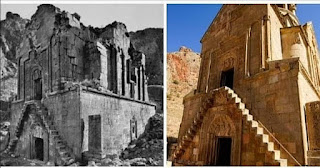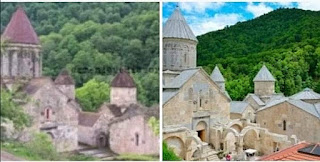Moscow cinema
Справочная информация об Армении
One of the amazing things about visiting Armenia is that the more you look around, the older the place gets. Armenia, situated along the route of the Great Silk Road, is a landlocked country of rugged mountains and extinct volcanoes, located in the southern Caucasus, between the Black Sea and Caspian Sea. It is the smallest of the former Soviet republics, bounded by Georgia on the north, Azerbaijan on the east, Iran on the south, and Turkey on the west. The area of the country is 30,000 sq. km. and the population is 3,000,000. Armenia lies in the highlands surrounding the Biblical mountain of Ararat, upon which Noah's ark came to rest after the flood.(Gen. 8:4).
History of Armenia
История Армении
Armenia was a regional empire with a rich culture in the years leading up to the 1st century BC, at one period controlling all the land between the Black and Caspian Seas. It also changed between various dynasties. But after Parthian (Iranian), Roman, Arab, Mongol and Persian occupation, Armenia had substantially weakened. In 1454, the Ottoman Empire and Safavid Persia divided Armenia among themselves. Persians ruled Eastern Armenia until 1828, when Russia annexed it. Large populations of Armenians in Ankara and Istanbul (Constantinople) did achieve a level of prosperity, and rose to prominence within the Ottoman government. Their prosperity was seen as a danger to the Turkish people, while they were increasingly relied on to prop up a decaying dynasty. On April 24, 1915, Armenian political and intellectual leaders were rounded up and killed. Armenian families were forced into death marches into the Syrian, Mesopotamian and Arabian deserts. Russia took Ottoman Armenia in 1916, reuniting the two lands for the first time since the 15th century. On May 28, 1918, the first Republic of Armenia was established, along with the Republics of Georgia and Azerbaijan. That independence lasted only for 2 years. In 1920 the republic of Armenia was part of the Soviet Union. On September 21, 1991, the population overwhelmingly voted in favor of independence in a national referendum, creating the second independent Armenian republic.
Let us now leave this province and turn to Greater Armenia. This is a very large province. Near the entrance to it stands a city called Erzrum, in which is made the best buckram in the world and countless other crafts are practiced. Here are the finest baths of spring water to be bound anywhere on earth. The inhabitants are Armenians and vassals of the Tartars. There are many towns and cities, of which the most splendid is Erzincan, which is the seat of an archbishop. The other chief cities are Erzrum and Ercis. In the heart of Greater Armenia is a very high mountain, shaped like a cube, on which Noah’s ark is said to have rested, whence it is called the Mountain of Noah’s Ark. It is so broad and long that it takes more than two days to go round it...
“The top of the mountain is almost always snow-covered and very hard to climb on. Snow almost never melts and new avalanches are constantly falling upon it. In the lower parts of the mountain, you could see a rich and abundant grass cover during warm seasons. In the summer, livestock is brought here to graze. Melting snow makes the soil dirty. The mountain is so wide that it takes more than two days to bypass it. Lesser Armenia also has many cities and villages. The inhabitants of Lesser Armenia were hunters. There was a city called Layas situated ashore. It was a city of trade – all goods from the East (gold, silk, spices) passed through this city, where merchants from different countries came together,” Marco Polo wrote.
Religion in Armenia
Религия в Армении
Christianity in Armenia can be traced back to the age of the Apostles. Two of Christ's Apostles - Thaddeus and Bartholomew - were the first evangelists of Armenia preaching the Gospel there as early as the second half of the century. In the early fourth century, St. Gregory the Illuminator (c. 240-332) formally established the church in Armenia in, when King Tiridates III waas baptized and proclaimed Christianity the official religion of Armenia. In 301, Armenia was the first state to formally adopt Christianity as its official state religion, 12 years before Rome.
The Armenian Church is one of the oldest branches of the Christian faith. The Armenian Church belongs to the Orthodox family of churches, known as the Oriental Orthodox or non Calcedonian Churches - namely, the Armenian, Coptic, Syrian, Ethiopian and Indian Malabar - churches. The functional structure of the Armenian Church is primarily based on the canons and established traditions of the Armenian Church, which were formulated over the centuries.
The Chief Bishop and Supreme Head of the Armenian Church is the Catholicos of All Armenians, who resides in Holy Etchmiadzin. A National Ecclesiastical Assembly consisting of lay and clergy representatives of the Armenian churches from around the world elects the Catholicos.
There are four hierarchical Sees in the Armenian Church: the Catholicate of All Armenians in Echmiadzin, the Catholicate of the Great House of Cilicia (established in Lebanon in 1930, but roots go back to the 13th century), the Patriarchate of Jerusalem (established in the early 14th century) and the Patriarchate of Constantinople (established in 1461).
Holy Echmiadzin is a primary spiritual seat of authority for the ten million Armenian Christians living in Armenia and in Diaspora communities around the globe. According to the 5th century Armenian historian Agathangelos, soon after the declaration of Christianity in Armenia, St. Gregory the Illuminator had a vision of Christ descending in a flood of light and pointing to the site where the first Armenian church was established. The church was completed in 303 A.D.
Culture in Armenia
Культура в Армении
The culture of Armenia encompasses many elements that are based on the geography, literature, architecture, dance, and music of the people. Armenian culture has strong influences from both its Eastern neighbors, as well as an underlying influence from Europe to the West. We may have lost a few wars in the past, but we still speak the same language our forefathers spoke thousands of years ago, and we can trace our distinct heritage way back before many civilizations were born.
The Armenian language dates to the early period of Indo-European differentiation and dispersion some 5000 years ago. Trade and conquest forced the language to change, adding new words into the people's vocabulary. Literature and books written in Armenian appeared by the 5th century. Many dialects appeared when Armenian communities became separated by geography or politics, and not all of these dialects are mutually intelligible.
Armenia is situated close to the Caucasus Mountains, and its music is a mix of indigenous folk music, perhaps best-represented Jivan Gasparyan's well-known duduk music, as well as light pop, and extensive Christian music, due to Armenia's status as the oldest Christian nation in the world.
Theater in Armenia has a tradition dating back more than 2,000 years.
Armenian cuisine is as ancient as the history of Armenia, a combination of different tastes and aromas. The food often has quite a distinct smell. Closely related to eastern and Mediterranean cuisine, various spices, vegetables, fish, and fruits combine to present unique dishes. Throughout history, Armenian cuisine has had cultural exchange with the cuisines of neighboring countries: Persian, Greek, Russian, Turkish, and Arab. Armenia is also famous for its wine and brandy. In particular, Armenian cognac is renowned worldwide (winner of several awards), and was considered by the late British Prime Minister, Sir Winston Churchill, as his favourite.
Nature of Armenia
Природа в Армении
With 8 geographic zones, 7climates, 9 altitudes, 16 soil zones; plus over half of all plant species in the Transcaucasus and two-thirds of all bird species found in Europe, Armenia’s small territory is a stunning biotops region. More varieties of topographies, plants and fauna can be found per square kilometer in Armenia than almost anywhere on earth. The closest rival for the same type of diversity its the USA, and it requires 100 times the space as Armenia. The relative ease of exploring these often over-lapping flora and fauna zones makes Natural Armenia a destination of its own.
Birding and Flower Watching have already put Armenia on the map, with birders and botanical tourists coming from around the world. Trekkers and Mountain Climbers can explore 85 mountains over a mile high, in diverse ranges that cover and divide the country into micro-climates and topographies. Mt. Aragast, Armenia's tallest mountain, can be surmounted in a tight 6 week span of July to mid-August. For avid spelunkers, the most spectacular images in Armenia are underground, and with more than 10,000 caves throughout the country, Armenia aims to please to subterranean explorer.
There are hundreds of mineral springs (both cold and hot) to delight taste buds and soothe tired bodies. There is even a hot spring at the top of a mountain, inside a dormant volcano. Other tourists can hike, bike, climb, glide, swim, boat and horseback ride their ways across the country, exploring remote regions where one feels alone in the world, or village-hopping, savoring the delights of home living.
Tourism in Armenia
Туризм в Армении





















































































No comments:
Post a Comment